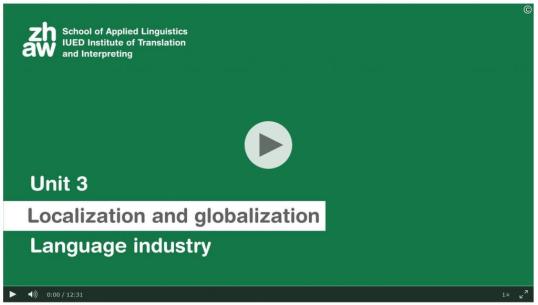
By Prof. Dr. Gary Massey, Director, IUED Institute of Translation and Interpreting, and Nicole Carnal, Head of the Specialisation in Professional Translation, MA in Applied Linguistics with Specialisation in Professional Translation, ZHAW Zurich University of Applied Sciences
A mounting number of publications and events, both academic and professional, have been addressing the position, roles and value of translators in the current and future translation ecosystem. Symptomatic of this trend is the last EMT meeting of 24-25 March 2021 focussed on “digital linguists” and a spate of recent conferences devoted wholly or partly to the conjunctions of artificial, cultural and intercultural intelligence in translation, interpreting and T&I education – such as last week’s excellent #AFFUMT event on the present and future of translator training.
Accelerating technological developments are reshaping the way professional language mediators work, changing processes, tasking and demand structures. The advance of NMT into the routine cognitive work of language industry professionals has hugely increased demand for post-editing and technology-led skills, but it is also opening spaces for adaptive experts able to identify, deliver and advise on the added value of language service provision beyond the scope of automation. At the same time, demographic developments and socio-ethical requirements to provide inclusive access to information and services are also extending the mediatory roles and responsibilities expected of language mediators, supported by assistive technologies, in a growing variety of settings. The multiple challenges and opportunities presented by digitalisation, technologisation and globalisation are diversifying the responsibilities, roles and working contexts of language industry professionals. They now go well beyond what has been prototypically associated with the professional designation, ‘translator’.
The agile dynamics of the language industry is the subject of a recent interview that our institute conducted with one of its graduates, Florian Faes – Managing Director of the language industry news and intelligence platform Slator. The last part of that interview was devoted to the value and position of the “humans in the loop,” the linguists, localisers, translators and many other professionals who are central to the industry.
Despite the “amazing” quality of MT, he sees no evidence of industry disruption. On the contrary, growing volumes are compensating the efficiency gains of automation, but this goes hand-in-hand with higher quality expectations. Language industry professionals must be “even better” in an environment where demand is driven by the realistic prospect of attainable high-quality translation, placing a premium on the value of the humans in the loop who must meet the vastly diverse profiles and roles that the industry requires.
Language Industry Studies: Teaching and researching professional diversity
The increasingly diverse language industry jobscape is a central feature of last year’s Slator 2020 Language Industry Market Report. It presents a list of no less than 700 buyer job titles, building on a 2018 study where some 600 titles were identified. Titles are grouped by function into eight categories, spanning language and quality, translation process management, localisation and operations management right through to marketing and communications. The core “language and quality” category alone contains over 50 separate titles, including such diverse designations as consultant, (digital) content editor, localisation specialist, lawyer-linguist, various types of specialised translators and interpreters, engineering manager, quality manager, terminologist, technical writer, copywriter and communications officer. “Translation process management” embraces even more – some 110 titles.
Diversification is also key to recent publications like the Bloomsbury Companion to Language Industry Studies (Angelone et al. 2020a). Localisation, transcreation, multimodal and audiovisual translation, user-centred translation, accessible barrier-free communication, revision, pre-editing, post-editing, terminological services, linguistic intercultural mediation, public service translation, language and communication consultancy – these are just some of the areas in which the professional group still largely known as ‘translators’ works. The solidification of closely related but autonomous profiles points in the same direction of diversification and diffusion – the example of post-editing with its own dedicated international standard (ISO 18587:2017) and specific competence modelling (Nitzke et al. 2019) springs most immediately to mind.
Of course, the multiplicity of tasks and activities has for some time been recognised by educational networks and institutions, with the broadening base of the EMT Competence Framework as an apt case in point. But the question remains as to how we, the educators, should respond on the ground.
One reasonably low-threshold option is to re-frame and re-orient parts of the curriculum as Language Industry Studies, a term and concept originally proposed by Angelone et al. (2020a) in a research context, and one rarely seen in translator education up to now. It advocates “a deliberate broadening of the scope of beyond translation and interpreting studies in research endeavours pertaining to today’s multifaceted language industry” (Angelone et al. 2020b, p. 5). The implications for training and pedagogy are legion and are discussed at length by Cathy Way (2020).
As you may already have guessed, the interview with Slator’s Managing Director is taken from an online teaching unit. It forms an initial component in rolling out a longer-term strategy at our home institution to increase student knowledge and awareness of the language and communication industries where they may eventually be working. This particular unit is embedded in the core first-year BA curriculum for all students in our School of Applied Linguistics, but other components have been flexibly integrated in further courses and modules offered on our BA and MA programmes.
The aim is to sensitise students from the start of their studies to the many career options available to them at graduation, and to provide them with a thorough knowledge of key facts, structures, processes and issues in a dynamic and ever-changing language industry. In addition to input on aspects of the industry in the form of lectures and online tutorials, seminar, workshop and independent-study activities at higher levels of proficiency include researching and reporting on industry end-client verticals, market segments, core services, buyer profiles and professional roles. In the past year, of course, there has been special interest in the way the industry has been faring during the COVID-19 pandemic. Students are also encouraged to develop industry-related research questions in their BA and MA theses.
By transversally integrating a growing suite of measures into our curricula, we are seeking to provide our students – as future language industry professionals – with much-needed tools and points of orientation to navigate the potentially bewildering array of professional demands and choices, challenges and opportunities in a rapidly evolving industry. We fully expect that, equipped with this up-to-date knowledge, they will be more able to find their way, place and identifiable added value in an ecosystem reaching far beyond the narrower prototypical concepts of translation per se.
References
Angelone, E., M. Ehrensberger-Dow M., & Massey, G. (Eds.). (2020a). The Bloomsbury companion to language industry studies. Bloomsbury Academic.
Angelone, E., Ehrensberger-Dow M., & Massey, G. (2020b). Introduction. In E. Angelone, E., M. Ehrensberger-Dow M., & G. Massey (Eds.), The Bloomsbury companion to language industry studies (pp. 1-13). Bloomsbury Academic.
Way, C. (2020). Training and pedagogical implications. In E. Angelone, E., M. Ehrensberger-Dow, & G. Massey (Eds.), The Bloomsbury companion to language industry studies (pp. 179-207). Bloomsbury Academic.
ISO 18587. (2017). Translation services — post-editing of machine translation output — requirements. Geneva: International Organization for Standardization.
Nitzke, J., Hansen-Schirra, S., & Canfora C. (2019). Risk management and post-editing competence, Journal of Specialised Translation, 31, 239-259.
Details
- Publication date
- 16 April 2021
- Language
- Dutch
- English
- German
- Italian
- Portuguese
- Spanish
- EMT Category
- Professional experience/employability

